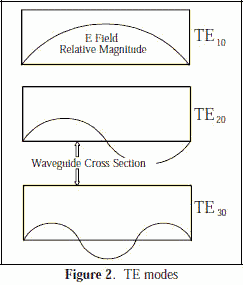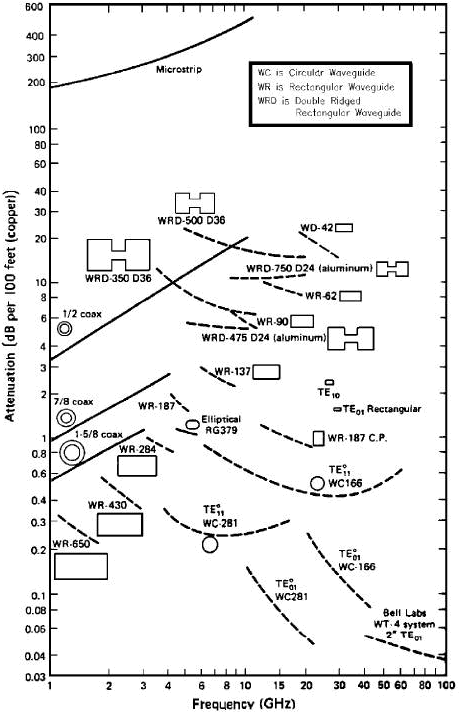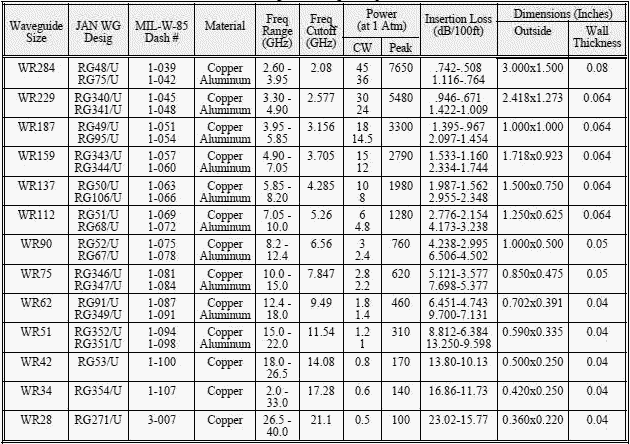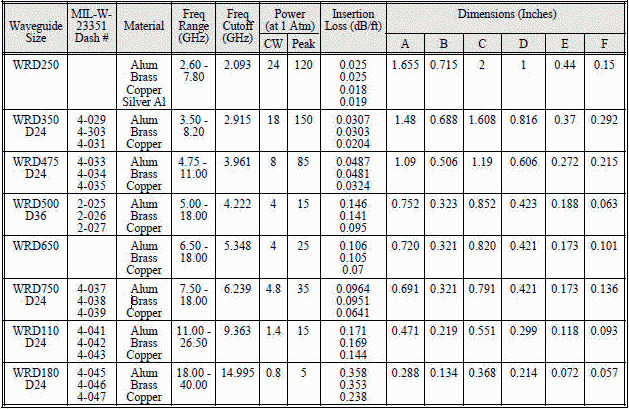|
[Go to TOC]
MICROWAVE WAVEGUIDES and COAXIAL CABLE
In general, a waveguide consists of a hollow metallic tube of arbitrary cross section uniform in extent in
the direction of propagation. Common waveguide shapes are rectangular, circular, and ridged. The rectangular
waveguide has a width a and height b as shown in figure 1. Commonly used rectangular waveguides have an aspect
ratio b/a of approximately 0.5. Such an aspect ratio is used to preclude generation of field variations with
height and their attendant unwanted modes. Waveguides are used principally at frequencies in the microwave range;
inconveniently large guides would be required to transmit radio-frequency power at longer wavelengths. In the
X-Band frequency range of 8.2 to 12.4 GHz, for example, the U.S. standard rectangular waveguide, WR-90, has an
inner width of 2.286 cm (0.9 in.) and an inner height of 1.016 cm (0.4 in.).

In waveguides the electric and magnetic fields are confined to the space within the guides. Thus no power is lost
to radiation. Since the guides are normally filled with air, dielectric losses are negligible. However, there is
some I2R power lost to heat in the walls of the guides, but this loss is usually very small. It
is possible to propagate several modes of electromagnetic waves within a waveguide. The physical dimensions of a
waveguide determine the cutoff frequency for each mode. If the frequency of the impressed signal is above the
cutoff frequency for a given mode, the electromagnetic energy can be transmitted through the guide for that
particular mode with minimal attenuation. Otherwise the electromagnetic energy with a frequency below cutoff for
that particular mode will be attenuated to a negligible value in a relatively short distance. This grammatical use
of cutoff frequency is opposite that used for coaxial cable, where cutoff frequency is for the highest useable
frequency. The dominant mode in a particular waveguide is the mode having the lowest cutoff frequency. For
rectangular waveguide this is the TE10 mode. The TE (transverse electric) signifies that all electric
fields
 are
transverse to the direction of propagation and that no longitudinal electric field is present. There is a
longitudinal component of magnetic field and for this reason the TEmn waves are also called Hmn
waves. The TE designation is usually preferred. Figure 2 shows a graphical depiction of the E field variation in a
waveguide for the TE10, TE20, and TE30 modes. As can be seen, the first index
indicates the number of half wave loops across the width of the guide and the second index, the number of loops
across the height of the guide - which in this case is zero. It is advisable to choose the dimensions of a guide
in such a way that, for a given input signal, only the energy of the dominant mode can be transmitted through the
guide. For example, if for a particular frequency, the width of a rectangular guide is too large, then the TE20
mode can propagate causing a myriad of problems. For rectangular guides of low aspect ratio the TE20
mode is the next higher order mode and is harmonically related to the cutoff frequency of the TE10
mode. It is this relationship together with attenuation and propagation considerations that determine the normal
operating range of rectangular waveguide. are
transverse to the direction of propagation and that no longitudinal electric field is present. There is a
longitudinal component of magnetic field and for this reason the TEmn waves are also called Hmn
waves. The TE designation is usually preferred. Figure 2 shows a graphical depiction of the E field variation in a
waveguide for the TE10, TE20, and TE30 modes. As can be seen, the first index
indicates the number of half wave loops across the width of the guide and the second index, the number of loops
across the height of the guide - which in this case is zero. It is advisable to choose the dimensions of a guide
in such a way that, for a given input signal, only the energy of the dominant mode can be transmitted through the
guide. For example, if for a particular frequency, the width of a rectangular guide is too large, then the TE20
mode can propagate causing a myriad of problems. For rectangular guides of low aspect ratio the TE20
mode is the next higher order mode and is harmonically related to the cutoff frequency of the TE10
mode. It is this relationship together with attenuation and propagation considerations that determine the normal
operating range of rectangular waveguide. The discussion on circular waveguides will not be included
because they are rarely used in the EW area. Information regarding circular waveguides can be found in numerous
textbooks on microwaves. CHARACTERISTICS OF STANDARD RECTANGULAR WAVEGUIDES Rectangular
waveguides are commonly used for power transmission at microwave frequencies. Their physical dimensions are
regulated by the frequency of the signal being transmitted. Table 1 tabulates the characteristics of the standard
rectangular waveguides. It may be noted that the number following the EIA prefix "WR" is in inside dimension of
the widest part of the waveguide, i.e. WR90 has an inner dimension of 0.90".
 DOUBLE
RIDGE RECTANGULAR WAVEGUIDE DOUBLE
RIDGE RECTANGULAR WAVEGUIDE Another type of waveguide commonly used in EW systems is the double ridge
rectangular waveguide. The ridges in this waveguide increase the bandwidth of the guide at the expense of higher
attenuation and lower power-handling capability. The bandwidth can easily exceed that of two contiguous standard
waveguides. Introduction of the ridges mainly lowers the cutoff frequency of the TE10 mode from that of
the unloaded guide, which is predicated on width alone. The reason for this can easily be explained when the field
configuration in the guide at cutoff is investigated. At cutoff there is no longitudinal propagation down the
guide. The waves simply travel back and forth between the side walls of the guide. In fact the guide can be viewed
as a composite parallel plate waveguide of infinite width where the width corresponds to the direction of
propagation of the normal guide. The TE10 mode cutoff occurs where this composite guide has its
lowest-order resonant frequency. This occurs when there is only one E field maximum across the guide which occurs
at the center for a symmetrical ridge. Because of the reduced height of the guide under the ridge, the effective
TE10 mode resonator is heavily loaded as though a shunt capacitor were placed across it. The cutoff
frequency is thus lowered considerably. For the TE20 mode the fields in the center of the guide will be
at a minimum. Therefore the loading will have a negligible effect.
For guides of proper aspect ratio, ridge height, and ridge width, an exact analysis shows that the TE10
mode cutoff can be lowered substantially at the same time the TE20 and TE30 mode cutoffs are
raised slightly. Figure 3 shows a typical double ridged waveguide shape and Table 2 shows double ridged waveguide
specifications. In the case of ridged waveguides, in the EIA designation, (WRD350 D36) the first "D" stands for
double ridged ("S" for single ridged), the 350 is the starting frequency (3.5 GHz), and the "D36" indicates a
bandwidth of 3.6:1. The physical dimensions and characteristics of a WRD350 D24 and WRD350 D36 are radically
different. A waveguide with a MIL-W-23351 dash number beginning in 2 (i.e. 2-025) is a double ridge 3.6:1
bandwidth waveguide. Likewise a 1- is a single ridge 3.6:1, a 3- is a single ridge 2.4:1, and a 4- is a double
ridge 2.4:1 waveguide. Figure 4 shows a comparison of the frequency /attenuation characteristics of various
waveguides. The attenuation is based on real waveguides which is higher than the theoretical values listed in
Tables 1 and 2. Figure 5 shows attenuation characteristics of various RF coaxial cables.

Figure 4. Attenuation vs Frequency for a Variety of Waveguides and Cables
Table 1. Rectangular Waveguide Specifications

Table 2. Double Ridge Rectangular Waveguide Specifications


Figure 5. Attenuation vs Frequency for a Variety of Coaxial Cables
Related Pages on RF Cafe
Table of Contents for Electronics Warfare and Radar Engineering Handbook
Introduction |
Abbreviations | Decibel | Duty
Cycle | Doppler Shift | Radar Horizon / Line
of Sight | Propagation Time / Resolution | Modulation
| Transforms / Wavelets | Antenna Introduction
/ Basics | Polarization | Radiation Patterns |
Frequency / Phase Effects of Antennas |
Antenna Near Field | Radiation Hazards |
Power Density | One-Way Radar Equation / RF Propagation
| Two-Way Radar Equation (Monostatic) |
Alternate Two-Way Radar Equation |
Two-Way Radar Equation (Bistatic) |
Jamming to Signal (J/S) Ratio - Constant Power [Saturated] Jamming
| Support Jamming | Radar Cross Section (RCS) |
Emission Control (EMCON) | RF Atmospheric
Absorption / Ducting | Receiver Sensitivity / Noise |
Receiver Types and Characteristics |
General Radar Display Types |
IFF - Identification - Friend or Foe | Receiver
Tests | Signal Sorting Methods and Direction Finding |
Voltage Standing Wave Ratio (VSWR) / Reflection Coefficient / Return
Loss / Mismatch Loss | Microwave Coaxial Connectors |
Power Dividers/Combiner and Directional Couplers |
Attenuators / Filters / DC Blocks |
Terminations / Dummy Loads | Circulators
and Diplexers | Mixers and Frequency Discriminators |
Detectors | Microwave Measurements |
Microwave Waveguides and Coaxial Cable |
Electro-Optics | Laser Safety |
Mach Number and Airspeed vs. Altitude Mach Number |
EMP/ Aircraft Dimensions | Data Busses | RS-232 Interface
| RS-422 Balanced Voltage Interface | RS-485 Interface |
IEEE-488 Interface Bus (HP-IB/GP-IB) | MIL-STD-1553 &
1773 Data Bus | This HTML version may be printed but not reproduced on websites.
|








 are
transverse to the direction of propagation and that no longitudinal electric field is present. There is a
longitudinal component of magnetic field and for this reason the TEmn waves are also called Hmn
waves. The TE designation is usually preferred. Figure 2 shows a graphical depiction of the E field variation in a
waveguide for the TE10, TE20, and TE30 modes. As can be seen, the first index
indicates the number of half wave loops across the width of the guide and the second index, the number of loops
across the height of the guide - which in this case is zero. It is advisable to choose the dimensions of a guide
in such a way that, for a given input signal, only the energy of the dominant mode can be transmitted through the
guide. For example, if for a particular frequency, the width of a rectangular guide is too large, then the TE20
mode can propagate causing a myriad of problems. For rectangular guides of low aspect ratio the TE20
mode is the next higher order mode and is harmonically related to the cutoff frequency of the TE10
mode. It is this relationship together with attenuation and propagation considerations that determine the normal
operating range of rectangular waveguide.
are
transverse to the direction of propagation and that no longitudinal electric field is present. There is a
longitudinal component of magnetic field and for this reason the TEmn waves are also called Hmn
waves. The TE designation is usually preferred. Figure 2 shows a graphical depiction of the E field variation in a
waveguide for the TE10, TE20, and TE30 modes. As can be seen, the first index
indicates the number of half wave loops across the width of the guide and the second index, the number of loops
across the height of the guide - which in this case is zero. It is advisable to choose the dimensions of a guide
in such a way that, for a given input signal, only the energy of the dominant mode can be transmitted through the
guide. For example, if for a particular frequency, the width of a rectangular guide is too large, then the TE20
mode can propagate causing a myriad of problems. For rectangular guides of low aspect ratio the TE20
mode is the next higher order mode and is harmonically related to the cutoff frequency of the TE10
mode. It is this relationship together with attenuation and propagation considerations that determine the normal
operating range of rectangular waveguide.  DOUBLE
RIDGE RECTANGULAR WAVEGUIDE
DOUBLE
RIDGE RECTANGULAR WAVEGUIDE



